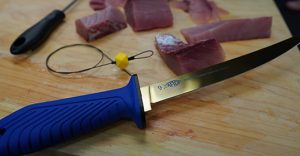Using a fish fillet knife effectively can make a significant difference in the quality of the fillet, the longevity of the knife, and the ease and safety of the filleting process. Here are five key tips to help maximize the effectiveness of a fish fillet knife.
1. Blade Size Matters: Selecting the Right Fillet Knife
Choosing the appropriate fillet knife begins with understanding the type of fish to be filleted. The size, shape, and density of the fish’s bones will dictate the ideal blade length. For smaller fish like trout, a smaller, flexible knife such as a 7-inch flex fillet knife is recommended. Larger fish may require a 9-inch flex fillet knife, while those with thicker bones, often found in saltwater species, may necessitate a breaker-style knife ranging from 8 to 12 inches.

2. Keep it Sharp: Sharpening a Fillet Knife
Maintaining a sharp blade is crucial for efficient and safe filleting. Since fillet knives are often crafted from softer steels to prevent chipping against bones, they tend to lose their edge more quickly. Regular honing before each use and sharpening at least once a year, or more frequently for regular use, are necessary. A sharp knife not only ensures clean cuts but also reduces the risk of injury, which often occurs with dull blades.
3. Spend Time Learning How to Clean a Fish
Mastering the art of filleting involves learning various techniques suited to different fish types. It’s beneficial to explore several methods and find a technique that matches the size and shape of the fish being filleted. Confidence in making precise cuts will grow with practice, leading to cleaner fillets and a more efficient process.
4. Multiple Knife Options Can Make Filleting Much Easier
Having a variety of knives can simplify the filleting process, especially as proficiency grows. A smaller, thinner knife is ideal for making precise cuts, while a thicker knife is better suited for cutting through tougher sections like rib bones. A flexible fillet knife combined with a breaking fillet knife can greatly enhance the ease and quality of the filleting process.

5. Post-Catch Care: Keeping Fish Fresh
Maintaining the freshness of fish starts immediately after the catch. The Ike Jime method, a simple four-step process, is highly effective in preserving freshness and improving taste. After cleaning the fish, proper storage is crucial. Vacuum sealing is recommended to extend the fish’s shelf life, ensuring fresh, great-tasting fish year-round.
These tips not only help in achieving better fillets but also contribute to a safer, more enjoyable fishing experience. Whether a novice or experienced angler, incorporating these strategies will enhance the overall quality and efficiency of fish filleting.
Images/Source: TakeMeFishing





